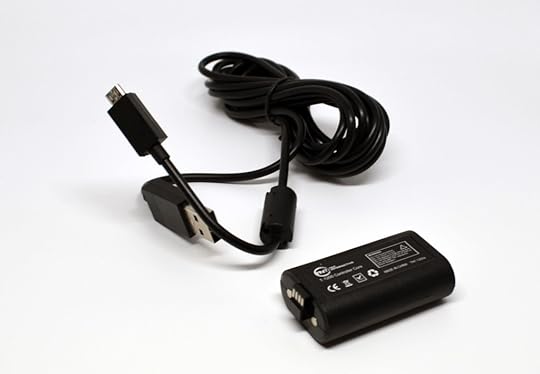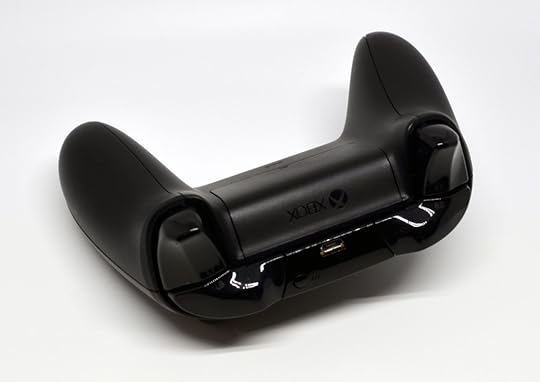Bill Loguidice's Blog, page 117
September 15, 2015
Review: T-1200 Controller Core Xbox One Rechargeable Battery
 While many of us like the convenience of using regular AA batteries with our standard Xbox One controllers, the reality is it’s not very eco-friendly. As an alternative, Microsoft makes their own rechargeable battery brick. Naturally, third parties make alternatives to that alternative. One such alternative to Microsoft’s solution is the TNT Interactive T-1200 Power Core.
While many of us like the convenience of using regular AA batteries with our standard Xbox One controllers, the reality is it’s not very eco-friendly. As an alternative, Microsoft makes their own rechargeable battery brick. Naturally, third parties make alternatives to that alternative. One such alternative to Microsoft’s solution is the TNT Interactive T-1200 Power Core.

The back of the box for the TNT Interactive T-1200 Power Core.

The insides of the box for the TNT Interactive T-1200 Power Core.
With the TNT Interactive T-1200 Power Core, you get the 1200mAh battery brick and a play and charge power cable. The battery fits neatly inside the standard Xbox One controller and behind the battery cover.

The battery and cable.
The play and charge power cable is a generous nine feet (about 2.7 meters) long. One end of the cable plugs into any USB port (including, of course, any of the ones on the Xbox One itself) and the other end plugs into the controller. An indicator light on the controller end of the cable glows red when charging and then changes to green when it’s topped off, which takes about four hours from full discharge. As the name indicates, the play and charge power cable can also be used for wired play on either an Xbox One or a PC running Windows 7 or later. Testing on my Windows 10 desktop PC was flawless.

Inserting the battery into the controller is a snap.

The battery gets covered up like normal.
Right now, the TNT Interactive T-1200 Power Core is only $15.95 on Amazon, which represents a small, but welcome savings over Microsoft’s first party offering.

The indicator like lets you know current charging status.
Thanks to TNT interactive for the review unit.
The post Review: T-1200 Controller Core Xbox One Rechargeable Battery appeared first on Armchair Arcade.
September 14, 2015
Infographic: 16 Facts About Nintendo’s The Legend of Zelda
What follows are 16 facts about The Legend of Zelda series, then an infographic that illustrates them:
Zelda and Mario (here) were developed at the same time, so the two borrowed some elements from each game. The fire bar from Zelda made its way to Mario and the piranha plant from Mario crossed over to the Zelda games.
You might notice Link’s green outfit and long cap that resembles another character. That is because Link is actually based on Walt Disney’s depiction of the boy who never grows old – Peter Pan.
The triforce has become an icon in itself that is almost always tied to the Zelda games. You can see this logo in every game. This emblem was based on a Japanese emblem called the Mitsuuroko, which translates to “The Three Dragon Scales.”
One thing that fans might not notice in some of the game art is that Link usually holds the sword in his left hand. That’s right. Link is (usually) left-handed.
The developers really put a lot of effort in the development of their dungeons. This is noticeable when you finally reach the second quest in the original The Legend of Zelda game. The first five dungeons from the second quest spell Z-E-L-D-A.
The Japanese developed the game, so it’s no surprise that they get more perks than in other countries. Aside from having a much better soundtrack quality in the game, the Japanese version of The Legend of Zelda also came with stickers.
Link was originally going to start with a sword, but late in the development of the game they decided to give it to him instead via an old man who tells him, “It’s dangerous to go alone! Take this.”
Speed runs are now famous in every video game out there. This is where people will try to finish the game in the fastest way possible. The Legend of Zelda is no exception either. “Lackattack24” is an addict gamer that entirely completed The Legend of Zelda in 30 minutes and 6 seconds.
According to Miyamoto, the name Zelda was inspired by the wife of author F. Scott Fitzgerald, who was named Zelda.
The second quest from The Legend of Zelda was an accident. This is all thanks to a programming mistake that left the cartridge with half of the memory free to use.
The late Robin Williams was such a big fan of The Legend of Zelda games that he named his daughter after the titular princess Zelda.
This game has quite a history with its foreign release. The first The Legend of Zelda almost didn’t get a U.S. release because former Nintendo of America president Minoru Arakawa didn’t think Americans had enough patience to understand the game.
The Legend of Zelda was originally called The Hyrule Fantasy: Legend of Zelda in Japan, but it got shortened to The Legend of Zelda instead for the American release. It just rolls off the tongue easier than Hyrule Fantasy.
The Ocarina of Time was planned to be a first person game, but because the developers knew that gamers love seeing Link in action, they ultimately scrapped that idea. After all, Link has been such a big part of the game that removing him from the screen could be quite a downer.
There is a hidden second quest in the first Zelda game. You can play this secret quest when you enter your name as “ZELDA”.
The Legend of Zelda was supposed to be a dungeon building simulator. Nintendo wanted to make use of the re-writable aspect of their newest platform after NES, the Famicom Disk System, so the Zelda game was being developed as a creation tool that let you build your very own dungeons. Over time, the company decided to drop that aspect and build the dungeon themselves.

Infographic Created by PureCostumes.com
The post Infographic: 16 Facts About Nintendo’s The Legend of Zelda appeared first on Armchair Arcade.
Infographic – 16 Facts About Nintendo’s The Legend of Zelda
What follows are 16 facts about The Legend of Zelda series, then an infographic that illustrates them:
Zelda and Mario (here) were developed at the same time, so the two borrowed some elements from each game. The fire bar from Zelda made its way to Mario and the piranha plant from Mario crossed over to the Zelda games.
You might notice Link’s green outfit and long cap that resembles another character. That is because Link is actually based on Walt Disney’s depiction of the boy who never grows old – Peter Pan.
The triforce has become an icon in itself that is almost always tied to the Zelda games. You can see this logo in every game. This emblem was based on a Japanese emblem called the Mitsuuroko, which translates to “The Three Dragon Scales.”
One thing that fans might not notice in some of the game art is that Link usually holds the sword in his left hand. That’s right. Link is (usually) left-handed.
The developers really put a lot of effort in the development of their dungeons. This is noticeable when you finally reach the second quest in the original The Legend of Zelda game. The first five dungeons from the second quest spell Z-E-L-D-A.
The Japanese developed the game, so it’s no surprise that they get more perks than in other countries. Aside from having a much better soundtrack quality in the game, the Japanese version of The Legend of Zelda also came with stickers.
Link was originally going to start with a sword, but late in the development of the game they decided to give it to him instead via an old man who tells him, “It’s dangerous to go alone! Take this.”
Speed runs are now famous in every video game out there. This is where people will try to finish the game in the fastest way possible. The Legend of Zelda is no exception either. “Lackattack24” is an addict gamer that entirely completed The Legend of Zelda in 30 minutes and 6 seconds.
According to Miyamoto, the name Zelda was inspired by the wife of author F. Scott Fitzgerald, who was named Zelda.
The second quest from The Legend of Zelda was an accident. This is all thanks to a programming mistake that left the cartridge with half of the memory free to use.
The late Robin Williams was such a big fan of The Legend of Zelda games that he named his daughter after the titular princess Zelda.
This game has quite a history with its foreign release. The first The Legend of Zelda almost didn’t get a U.S. release because former Nintendo of America president Minoru Arakawa didn’t think Americans had enough patience to understand the game.
The Legend of Zelda was originally called The Hyrule Fantasy: Legend of Zelda in Japan, but it got shortened to The Legend of Zelda instead for the American release. It just rolls off the tongue easier than Hyrule Fantasy.
The Ocarina of Time was planned to be a first person game, but because the developers knew that gamers love seeing Link in action, they ultimately scrapped that idea. After all, Link has been such a big part of the game that removing him from the screen could be quite a downer.
There is a hidden second quest in the first Zelda game. You can play this secret quest when you enter your name as “ZELDA”.
The Legend of Zelda was supposed to be a dungeon building simulator. Nintendo wanted to make use of the re-writable aspect of their newest platform after NES, the Famicom Disk System, so the Zelda game was being developed as a creation tool that let you build your very own dungeons. Over time, the company decided to drop that aspect and build the dungeon themselves.

Infographic Created by PureCostumes.com
The post Infographic – 16 Facts About Nintendo’s The Legend of Zelda appeared first on Armchair Arcade.
Review: Tripmate Portable Router, NAS, and Power Bank
 When practical, combining certain portable products into one compact unit just makes sense. For instance, instead of carrying a separate portable battery and router, the HooToo TripMate Titan (HT-TM05) combines those functions into a single unit, while also functioning as a Network-attached storage (NAS) server. It’s really an impressive feature-set, especially for a device that measures just 3.74 inches (95 mm) high and 1.73 inches (44 mm) long, and weighs a little over half a pound (about 9.3 ounces).
When practical, combining certain portable products into one compact unit just makes sense. For instance, instead of carrying a separate portable battery and router, the HooToo TripMate Titan (HT-TM05) combines those functions into a single unit, while also functioning as a Network-attached storage (NAS) server. It’s really an impressive feature-set, especially for a device that measures just 3.74 inches (95 mm) high and 1.73 inches (44 mm) long, and weighs a little over half a pound (about 9.3 ounces).

The front of the box for the HooToo TripMate Titan.

The back of the box for the HooToo TripMate Titan.
The Tripmate Titan has a 10400mAh power bank, which is good for not only running the device itself for potentially tens of hours, but can also charge demanding USB-powered devices like large smartphones and tablets multiple times through its 5V/2.1A USB port. As for charging this battery in the Tripmate Titan, the device has a standard micro-USB port (5V/1.6A), so, if the included cable isn’t handy, it should be no issue grabbing one that is.

The HooToo TripMate Titan comes with a micro-USB cable, fold-out quick start guide, and the device itself.

A size comparison of the HooToo TripMate Titan versus an Apple iPhone 6 Plus.
As for the router functionality, there’s a lot to it. In Access Point (AP) mode, you can plug a standard network cable into the RJ45 ethernet port and then provide wireless access (802.11b/g/n, 2.4GHz) for any combination of five wi-fi-enabled devices. This is great for hotel rooms where only a single network cable is provided. Of course, there’s also Bridge mode for similar situations where you want to share the connection and only a limited number of devices (usually one or two per room using our hotel example) are allowed onto a protected wi-fi network. Finally, in Router mode, you can connect the Tripmate Titan to a cable or DSL modem and use it like a regular wireless router.

The RJ45 ethernet port and reset button.
NAS functionality lets you hook up one USB flash or hard drive (FAT 16/32 and NTFS, 4TB maximum) directly to the device, or, as many as four if you use a separate USB hub. Up to five devices can then simultaneously access any connected USB storage device, making media sharing and streaming a breeze. In fact, if a hub is used, you can also transfer files between any of the attached drives with the same HooToo TripMate Plus Windows, Macintosh, iOS, or Android app you use for setup (all found on the Website, where you can also easily update the firmware and get an extended manual).

The micro- and full-sized-USB ports.
In addition to streaming media from connected USB storage, the Tripmate Titan allows devices like the Chromecast, Roku, or other DLNA-enabled devices to work on the most authentication-heavy networks (again, like those found in hotels), so your options on-the-go are extensive.

The power button and indicator LEDs.
On the top of the device is a power button, where a short press of one second activates the battery LED indicators and a long press of three seconds activates the Internet/LAN, four LEDs, and a Wi-Fi LED. For the four LEDS, one LED indicates 0 – 25% of the battery is left, two LEDs indicate 26 – 50%, three LEDs indicate 51 – 75%, and all four LEDs indicate 76 – 100%. For the Wi-Fi LED, flashing blue indicates the system is loading, solid blue indicates system loaded, flashing green indicates connecting to the Internet, and solid green indicates Internet connected. Pressing the reset button next to the LAN port for 10 seconds resets the Tripmate Titan.
As you can see, it’s a high function, highly portable device. The build quality, warranty, and support are also excellent. My only criticism is that I’m not a fan of the rubber flaps that cover the ports on the upper part of the unit since they don’t always stay in place easily. That’s admittedly a minor criticism, however, and one not related to how well the device itself works.
As a special offer for Armchair Arcade readers, here’s a discount code for $10 off the TripMate on Amazon, good from September 14 – 28, 2015: OIWWJQU6. That brings your cost down to a low $49.99. September 14 – 28 is also when HooToo’s #IntotheWired contest runs, which is also worth checking out and can be found at: http://www.hootoo.com/intothewired.html.
Thanks to HooToo for the review unit.
The post Review: Tripmate Portable Router, NAS, and Power Bank appeared first on Armchair Arcade.
September 9, 2015
Infographic – Making Mario: The Creation and Evolution of Mario
What follows is a rather nice infographic for Nintendo’s iconic Mario, courtesy of HalloweenCostumes.com. Personally, I’ve always found classic pixel art far more beautiful than most rendered or polygonal images, and I think this particular infographic is a great illustration of that.
I particularly love the personality found in the 1983 Mario from one of my favorite two player simultaneous games, Mario Bros. In contrast, I find the 2002 – NOW image rather sterile. This infographic is no doubt in celebration of the imminent release of the amazing looking Wii U title, Super Mario Maker, one of the few games on the platform I’m genuinely looking forward to.
Finally, if you’d like, you can read more about Mario and the classic Nintendo platforms in a couple of my books, Vintage Games: An Insider Look at the History of Grand Theft Auto, Super Mario, and the Most Influential Games of All Time, and Vintage Game Consoles: An Inside Look at Apple, Atari, Commodore, Nintendo, and the Greatest Gaming Platforms of All Time. Of course, we also talk about Mario and Nintendo in our film, Gameplay: The Story of the Videogame Revolution (Website and DVD). Enjoy!

Image Created by HalloweenCostumes.com
September 8, 2015
Magazine Hindsight (001) : Computer Gaming World, 08/1986
In this ongoing Armchair Arcade series, I take a look at random videogame- and computer-centric magazines from years’ past. I’ll point out particularly interesting content within each magazine and provide commentary from the perspective of what we know now. Whenever possible, I’ll provide direct links to PDF scans of the material so you can follow along.
Today’s feature, 001, is on the August 1986 issue of Computer Gaming World, which is issue 30.

Computer Gaming World, 08/1986 (cover)
Starting with the cover, I know I’m already in for a treat as artwork from SSI’s Phantasie II box is featured. The Phantasie series was my first proper introduction to Dungeons & Dragons pen and paper-style role-playing on a computer – in this case my Commodore 64 (C-64) – and it left a lasting impression. I also had fun with the other game mentioned on the cover, GBA Championship Basketball and dabbled with Activision’s Gamemaker, although I never ended up making much with it. I’m not sure what American Dream is, so I’ll be curious to find out. In any case, there’s a lot to be said for Computer Gaming World‘s (hereafter, CGW) cover design, as the artwork against the blue background and clean lettering is particularly classy. It’s understated in a way that today’s magazines simply wouldn’t be able to attempt.
On page 5, in the Taking a Peek column (short previews), a mention is made of a “nice new entry into the ranks of chess programs,” called Chessmaster 2000, available for Apple II, Atari 8-bit, C64/128, Amiga, and Atari ST (and as was normal for the time, suggesting to Circle Reader Service # 23 on the magazine’s advertiser’s card to potentially get more information mailed to you). Chessmaster was of course a long running multi-platform series that made it into the modern era, and was arguably the most popular chess simulation series of all time. Ubisoft last held the rights, but it’s unclear to me who owns them now. Either way, it’s not possible to play a version of the game on a modern platform, which is a pity because I always liked the core concept of playing against computer opponents with different personalities rather than just a generic opponent. The latest version I own is for the Microsoft Xbox 360, followed by versions for the Nintendo DS and Sony PlayStation 2. While I still can play on any of those systems any time I want, I’d much rather have a version for a newer platform, and especially on the PC side.
Also mentioned on page 5 is The American Challenge, a match race sailing simulation for Apple II and IBM (and compatible) computers. Sailing simulations were definitely a thing at one time, although I can’t think of any prominent titles these days.
On page 10 is an ad for Dragon Fire II: The Dungeonmaster’s Assistant, which works on IBM PCs and compatibles, C-64, and Apple II. The only other major commercial dungeon master assistant I was aware of was the stuff from SSI during the Gold Box era. I suppose the advantage of this one is that it was meant to be somewhat generic and work with most pen and paper role playing systems. It’s an interesting artifact even if I’ve never heard of it before myself.

Computer Gaming World, 08/1986 (page 12)
On page 12 is American Dream: The Management Simulation from Blue Chip Software (BC) for the IBM PC and compatibles. Now I know what it is. I’m intimately familiar with BC’s earlier management simulations like Millionaire and always liked the padded vinyl packaging (later releases went to cardboard), but perhaps because this particular game was not multi-platform like the others (not surprising since this one is not strictly text-based like the earlier games) relegated it to greater obscurity. As usual, BC wasn’t shy about pricing their software sky high, this one at $124.95 (about $272.06 in today’s dollars!). Presumably the target audience was high powered business executives.
Page 16 has the Phantasie II review (original Apple II version) by the infamous Scorpia. She makes good points, in that even at the time I thought Phantasie II was really just a bug fixed minor update of the first Phantasie game. I still loved it, however, and the concluding paragraph of the review more or less agrees:
“Bottom line: Although flawed in certain aspects, Phantasie II is an interesting, and overall good, game of the RPG type; if you liked the original Phantasie, you won’t want to miss this one.“
Page 20 has a rather breathless review of GBA Championship Basketball: Two On Two. It was a favorite of mine too, only surpassed a few years later for me by Cinemaware’s TV Sports: Basketball. Either way, it’s still good for a spin now and again.
Page 24 features a Consumer Electronics Show and Origins: The National Strategy and Adventure Gaming Convention post-mortem, discussing some of the games shown there.

Computer Gaming World, 08/1986 (page 25)
Page 25 has the first mention of Cinemaware and some of their upcoming titles, including what would be the Amiga’s killer app, Defender of the Crown. Needless to say, the writer was very impressed by the upcoming Cinemaware offerings (page 46, where the story continues, there’s mention of Star Rush, which I’m pretty sure was never released in any form).
Page 26 shows Amiga game momentum building, with mention of another popular early title, the arcade conversion for Marble Madness. Notable is early Amiga game, Mind Walker, being written as Mynd Walker. There’s also a mention of the graphical Epyx release of Rogue.
Page 28 is interesting. Notable is the mention of the influx of British software into the US, as well as something that I’ve talked about many times, and that’s how quickly the US moved away from cassette software and onto disk software versus almost every other territory, particularly Britain. The author quotes 97% of all Commodore 64 users having disk drives. While I think that’s probably a bit high, even for 1986, I suspect that number wasn’t even a quarter of that in the UK, where they were far more price sensitive.
For those that lament that today’s games are released buggy, page 30 shows that was also sometimes the case in the past as well. Being an owner of Star Trek: The Kobayashi Alternative from back in the day, I can definitely confirm some of the bugs mentioned.
It’s nice to see they have a Macintosh column on page 36. While it was never a premiere gaming platform, it definitely had some interesting releases in the 80s.

Computer Gaming World, 08/1986 (page 39)
Page 39 has a Game Designers’ Workshop ad. Combined with some of the other ads, including those from SSI, and the general editorial content, it’s clear to see that a big portion of CGW’s audience at the time must have been into simulations. Targeted advertising (and an early form of narrow-casting) at its best.
Page 44 has mention of more Commodore 64s being sold than any other home computer, with a claim from Commodore of 3.5 million combined C-64s and C-128s. As we know now, the Commodore 64 would retain that title, selling quite a few more units worldwide into the early part of the 90s. As I recounted in Vintage Game Consoles: An Inside Look at Apple, Atari, Commodore, Nintendo, and the Greatest Gaming Platforms of All Time, unfortunately, various factors have contributed to the final official number being difficult for historians to determine. Sales have been reported by various sources as anywhere between 12 and 30 million. Even taking the lowest number, it’s still more than any other single computer (the C-128, often wrongly considered a failure, reportedly sold close to six million units when all was said and done, though again, I wouldn’t take those figures as definitive).

Computer Gaming World, 08/1986 (page 48)
Page 48 has a nice reader-driven rating summary for various games. The games on the list again clearly indicate the editorial focus of the publication.

And just to finish off the feature is the back cover, which has a nice Origin advertisement.
September 7, 2015
Review: Aennon LED Work Light Flashlight
 When searching for a good work light, versatility and durability are both keys to how useful it can actually be. The Aennon LED Work Light Flashlight hits both of those points.
When searching for a good work light, versatility and durability are both keys to how useful it can actually be. The Aennon LED Work Light Flashlight hits both of those points.

The box for the Aennon LED Work Light Flashlight.
Its top light is a five LED flashlight with 30 lumens of brightness. Its main light, which is designed to light up a larger area, uses COB technology. COB, or Chip-on-Board, is a newer technology where multiple LED chips are packaged together as one lighting module. This allows for an energy efficient 150 lumens and more than 100,000 hours of use.

The rear of the Aennon LED Work Light Flashlight. Note the hook and magnets.
The Aennon LED Work Light Flashlight‘s body is rubberized, and is both shock-proof and water resistant. The adjustable, pivoting head tilts up to 270°, and makes a satisfying click as it locks into each angle. While it has a powerful dual magnet base, if a metal surface is not available, there’s also a 360° rotatable swivel hook for hanging. Of course, it also stands fine all on its own.
When you first get the light, you’ll want to remove the three AA batteries included in the battery compartment so the no-contact circles fall out. You then re-insert the batteries, which can now make contact and power the device.

The Aennon LED Work Light Flashlight can stick, hang, or stand just about anywhere.
Overall, it’s a nice design at a good price point (only $15.99 right now on Amazon for one, $26.97 for two, or $37.97 for three). My only criticism is that both LED light sources are extremely bright and unfiltered, so it’s very easy to temporarily blind yourself if you accidentally catch a look. With that said, I’m not sure if there’s any way around that without diminishing some of its utility. If you need a bright, focused work light that can also double as a flashlight, this is definitely a great choice.
August 30, 2015
Review: DreamSpa AquaFan Rainfall LED/LCD Shower Head
 Your shower head is not necessarily the first item you’d think of for a high tech replacement. The DreamSpa AquaFan 12″ All-chrome Rainfall Shower Head with Color-Changing LED/LCD Temperature Display, however, may force you to reconsider.
Your shower head is not necessarily the first item you’d think of for a high tech replacement. The DreamSpa AquaFan 12″ All-chrome Rainfall Shower Head with Color-Changing LED/LCD Temperature Display, however, may force you to reconsider.

You get the shower head, plumber’s tape, and instructions (front view).

You get the shower head, plumber’s tape, and instructions (rear view).
The AquaFan fits any standard shower arm, i.e., pretty much any shower arm without a ball end, so installation is simple. Simply unscrew your existing shower head (you may need a wrench), optionally (but always recommended for leak protection) wrap some of the included plumber’s tape around the extension pipe’s threads, and then screw the AquaFan on. That’s it. Naturally, more detailed instructions are included, which you should of course follow, but either way, I can’t imagine anyone running into any problems.

Remove the old shower head and then wrap the plumber’s tape around the pipe thread.
The shower head includes a numeric LCD temperature display with LEDs that change color with the associated water temperature: Blue = cool/below 95° F (35° C), Green = warm/95° F – 109° F (35° C – 42° C), Red = Hot/109° F – 122° F (45° – 50° C), and Flashing Red = Warning Very Hot/above 122° F (50° C), aka “for the ladies.” “Rainfall” is simulated with 123 jets of water from the chrome-plated (no chipping!) ABS plastic head.

The shower head installed with no running water.

The temperature starts out cool, so the LED is blue.
In terms of power supply, there is none. The AquaFan gets all it needs from the running water. As you would expect, the LED lights are rated for approximately 100,000 hours, or more than 10 years of daily use.
As required by US federal law, a water flow regulator is pre-installed within the shower head. Unless your water pressure is extremely low, this shouldn’t be bypassed. Assuming our home is average in terms of water pressure, I noticed no real difference between this shower head and our previous, more traditional shower head.
If you’d like a more high tech and spa-like shower head, it’s hard to go wrong with the AquaFan.
Review: Gunilamp 9.5w Bluetooth LED Smart Light Bulb
 Just when many of us got through transitioning most, if not all, of our incandescent bulbs to far more efficient compact flourescent light (CFL) bulbs, along came practical light-emitting diode (LED) bulbs to put both to shame. In terms of brightness, efficiency, and versatility, LED bulbs can’t be beat, albeit still for a premium price over other bulb types.
Just when many of us got through transitioning most, if not all, of our incandescent bulbs to far more efficient compact flourescent light (CFL) bulbs, along came practical light-emitting diode (LED) bulbs to put both to shame. In terms of brightness, efficiency, and versatility, LED bulbs can’t be beat, albeit still for a premium price over other bulb types.

The packaging for the Gunilamp 9.5w Bluetooth LED Smart Light Bulb.
In regards to that versatility, LED bulbs can house electronics that allow for remote control of color, brightness, and other functionality. Of course, many of these smart bulbs are often over-engineered or come with sky high price tags. One bulb that does offer a good basic feature set and reasonable price point (only $38.67 on Amazon right now) is the Gunilamp 9.5w Bluetooth LED Smart Light Bulb, which works with an iOS or Android smartphone app or optional remote control (sold separately) to allow adjusting of color, brightness, vividness, and powering on or off.

Inside the box is the bulb and an instruction sheet.
The bulb itself screws into any standard light socket (E26/E27) and approximates the shape of classic incandescent bulbs, albeit with quite a bit more weight due to the design of the heat sink and the extra bit of electronics. As you can tell from the photos, it’s a stylish design and looks inconspicuous once set into the light socket.
The Gunilamp Pro app is available from either the Apple App Store or Google Play store and works with iOS devices supporting iOS 6.0 or greater, or Android devices supporting Android 4.3 or greater. For the latter, the device must also support Bluetooth 4.0.

The app on the Apple App store.

You need to select the bulb in the app every time you want to change its settings.
From the app, you can easily manually change colors and brightness, set an “alarm” to turn the bulb on at a specific time, or set one of seven preset modes, including Sleep (greenish hue), Reading (yellowish hue), Love (redish hue), and Dance (color cycling). Although it used to be that only iOS users could control up to nine bulbs at the same time, a recent app update for Android now allows for the same functionality.

Some of the app’s features.
The app itself, while usable, is not particularly intuitive. Nevertheless, you should still be able to set the bulb exactly the way you want it with just a little bit of experimentation, keeping in mind that if you shut the bulb off from the light switch it will revert to a standard white light when you turn it back on. Note also that for me to get the bulb to work with the app on my Apple iPhone 6 Plus, I had to reboot my phone. After that, it worked fine. On one of my daughter’s Android phones, a Motorola Moto G, I couldn’t get the app to work with the bulb the first time either, but there was no issue after we reinstalled the app.
Here’s a quick Instagram video of the bulb in Dance mode while I play some dance music on the Amazon Echo:
A video posted by Bill Loguidice (@bill_loguidice) on Aug 30, 2015 at 8:36am PDT
With a lifetime of over 40,000 hours (or approximately 22 years of use), this is one bulb that is designed to last. Combined with the savings on electricity you get with the more efficient LED technology (as well as the ability to make it as dim as you’d like), there’s no denying how much value is packed into this bulb. I genuinely appreciate how bright this bulb can get and how versatile the various color modes are.

A photo of its whitest light.

One of the countless colors you can choose.
August 26, 2015
Review: Arespark Self Picture Monopod
I admit it, I’ve had it with selfie stick reviews. I steadfastly refuse to review them unless they offer some type of differentiator from their Tribble-like brethren. Naturally, the Arespark Self Picture Monopod offers just such a differentiator or I wouldn’t bother having written this very review you’re reading right now.

The box for the Arespark Self Picture Monopod.
I’ll start out by taking a look at the monopod itself. Thanks to three locks, like those found on a good tripod, it contracts and extends to a minimum of 16″ and maximum of 50″. It also rotates 180 degrees. It’s durable and solidly built, with an extremely comfortable grip, which accepts an included strap for extra security. Since there are no electronics in the monopod, a Bluetooth Remote Shutter, aka the differentiator, is included. It features two buttons, one for iOS smartphones and another for Android smartphones, as well as an ON/OFF switch and an LED status indicator. The required CR2032 button cell battery is also included, and is rated to last about six months when used 10 times a day.

The insides of the box for the Arespark Self Picture Monopod.
The remote shutter is about the size of a car remote and pairs easily with iOS, which in my case was my Apple iPhone 6 Plus. As mentioned, it also works with Android, but if your phone’s camera app doesn’t default to using the volume buttons for a shutter, you’ll need to download something that does like Camera 360. A strap is included if you’d like to attach it to the remote.

The Arespark Self Picture Monopod at full extension.
Smartphones between 5.6 – 8.5 centimeters – which is most of them, big and small – work just fine with the included expandable holder. Separate mounts for camera tripods and GoPros are also included in this value-packed bundle, which is only $18.99 right now on Amazon.

A quick selfie with one of my daughters and a few of our pets.
In the end, while this is indeed yet another selfie stick, it’s also a decidedly premium model with lots of extras included that addresses one of the major stumbling blocks that are presented with other devices like this, which is pressing the shutter button while trying to keep everything steady. The Bluetooth Remote Shutter is a fantastic differentiator for a very crowded product category and has uses well beyond selfies. In fact, I suspect the nifty remote shutter may still see use even if selfie haters get their wish and the product category goes the way of the pet rock.
Thanks to Arespark for the review unit.



